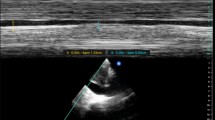Abstract
Various degrees of left ventricular outflow tract (LVOT) obstruction have been seen in patients with subvalvular aortic stenosis (SAS). Regional analgesia during labor for parturients with SAS is relatively contraindicated because it has a potential risk for hemodynamic instability due to sympathetic blockade as a result of vasodilation by local anesthetics. We thought continuous spinal analgesia (CSA) using an opioid and minimal doses of local anesthetic could provide more stable hemodynamic status. We demonstrate the management of a 28-year-old pregnant patient with SAS who received CSA for her two deliveries. For her first delivery (peak pressure gradient (∆P) between LV and aorta was approximately 55 mmHg), intrathecal fentanyl was used as a basal infusion, but we needed a small amount of bupivacaine to provide supplemental intrathecal analgesia as labor progressed. Although there were mild fluctuations in hemodynamics, she was asymptomatic. For her second delivery (∆P between LV and aorta was approximately 90 mmHg), minimal doses of continuous bupivacaine were used as a basal infusion. For her additional analgesic requests, bolus co-administration of fentanyl was effective. There were no fluctuations in her hemodynamics. Although her SAS in her second pregnancy was more severe than in the first, her hemodynamics exhibited less fluctuation during the second delivery with this method. In conclusion, CSA using fentanyl combined with minimal doses of bupivacaine provided satisfactory analgesia and stable hemodynamics in parturient with severe SAS.
Similar content being viewed by others
References
Okutomi T, Kikuchi S, Amano K, Okamoto H, Hoka S. Continuous spinal analgesia for labor and delivery in a parturient with hypertrophic obstructive cardiomyopathy. Acta Anaesthesiol Scand. 2002;46:329–31.
Van de Velde M, Budts W, Vandermeersch E, Spitz B. Continuous spinal analgesia for labor pain in a parturient with aortic stenosis. Int J Obstet Anesth. 2013;12:51–4.
Moghbeli N, Pare E, Webb G. Practical assessment of maternal cardiovascular risk in pregnancy. Congenit Heart Dis. 2008;3:308–16.
Sanghavi M, Rutherford JD. Cardiovascular management in pregnancy. Cardiovasc Physiol Pregnancy. Circ. 2014;130:1003–8.
Robson SC, Dunlop W, Boys RJ, Hunter S. Cardiac output during labor. Br Med J. 1987;295:1169–72.
Thompson RC, Liberthson RR, Lowenstein E. Perioperative anesthetic risk of noncardiac surgery in hypertrophic obstructive cardiomyopathy. JAMA. 1985;254:2419–21.
Suntharalingam G, Dob D, Yentis SM. Obstetric epidural analgesia in aortic stenosis: a low-dose technique for labour and instrumental delivery. Int J Obstet Anesth. 2001;10:129–34.
Minnich ME, Quirk JG, Clark RB. Epidural anesthesia for vaginal delivery in a patient with idiopathic hypertrophic subaortic stenosis. Anesthesiology. 1987;67:590–2.
Ho KM, Ngan Kee WD, Poon MCM. Combined spinal and epidural anesthesia in a parturient with idiopathic hypertrophic subaortic stenosis. Anesthesiology. 1997;87:168–9.
Abboud TK, Zhu J, Sharp R, LaGrange C, Rosa C, Kassells B. The efficacy of intrathecal injection of sufentanil using a microspinal catheter for labor analgesia. Acta Anaesthesiol Scand. 1996;40:210–5.
Gaiser RR, Cheek TG, Gutsche BB. Comparison of three different doses of intrathecal fentanyl and sufentanil for labor analgesia. J Clin Anesth. 1998;10:488–93.
Honet JE, Arkoosh VA, Norris MC, Huffnagle HJ, Silverman NS, Leighton BL. Comparison among intrathecal fentanyl, meperidine, and sufentanyl for labor analgesia. Anesth Analg. 1992;75:734–9.
Okutomi T, Mochizuki J, Amano K, Datta S. The effect of intrathecal epinephrine on epidural infused analgesics during labor. Reg Anesth Pain Med. 2003;28:108–12.
Muralidhar V, Kaul HL, Mallick P. Over-the-needle versus microcatheter-through-needle technique for continuous spinal anesthesia. Preliminary study. Reg Anesth Pain Med. 1999;24:417–21.
Möllman M, Van Steenberge A, Sell A, Pitkanen M, Holst D, Van Dongen A, Berg S. Spinocath, a new approach to continuous spinal anesthesia—preliminary results of a multicenter trial. Int Monit. 1996;8:74.
Gosch UW, Hueppe M, Hallschmid M, Born J, Schmucker P, Meier T. Post-dural puncture in young adults: comparison of two small-gauge spinal catheters with different needle design. Br J Anaesth. 2005;94:657–61.
Author information
Authors and Affiliations
Corresponding author
About this article
Cite this article
Hyuga, S., Okutomi, T., Kato, R. et al. Continuous spinal labor analgesia for two deliveries in a parturient with severe subvalvular aortic stenosis. J Anesth 30, 1067–1070 (2016). https://doi.org/10.1007/s00540-016-2238-6
Received:
Accepted:
Published:
Issue Date:
DOI: https://doi.org/10.1007/s00540-016-2238-6




